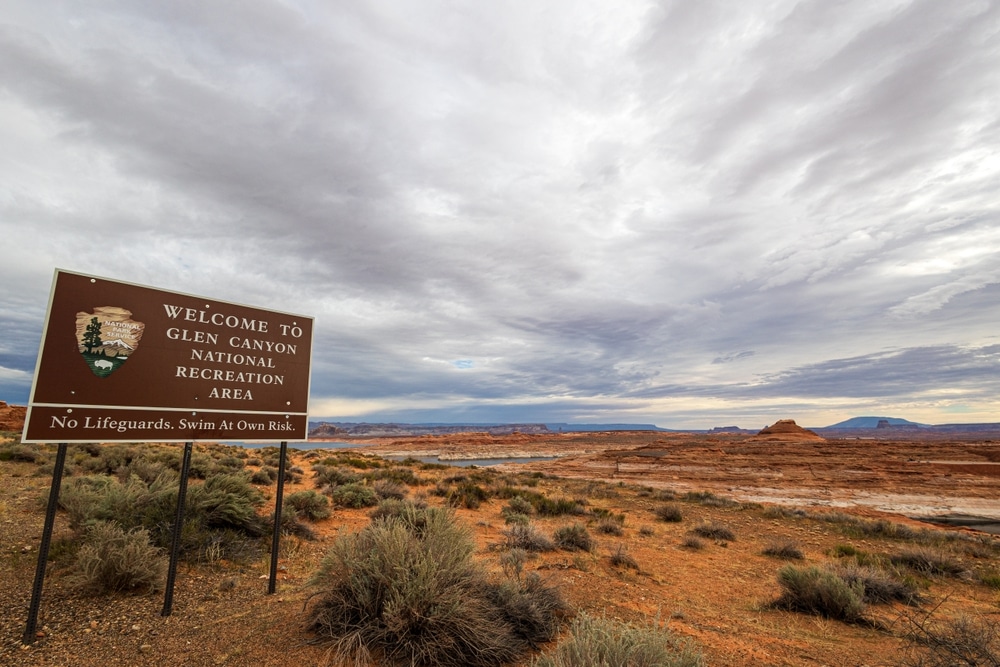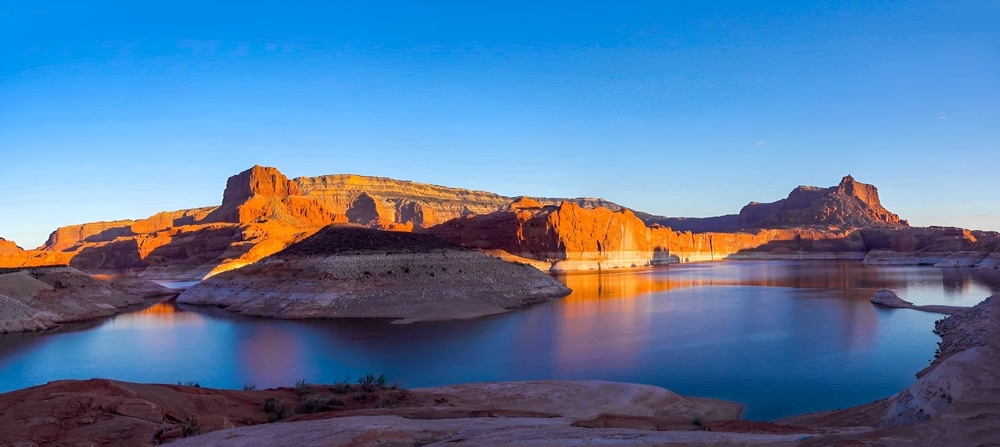Arizona’s Glen Canyon National Recreation Area stands as a testament to the extraordinary diversity of landscapes found throughout the American Southwest. Encompassing over 1.25 million acres stretching across the border between Arizona and Utah, this vast recreation area offers unparalleled opportunities for both water-based recreation and backcountry exploration. From the cobalt blue waters of Lake Powell to the dramatic red rock canyons and mesas, Glen Canyon presents visitors with a stunning contrast of desert and aquatic environments.
Established in 1972, Glen Canyon National Recreation Area’s primary purpose is twofold: to provide public recreation opportunities and to preserve the area’s scientific, historic, and scenic features. The recreation area was named for Glen Canyon, which was largely flooded with the completion of the Glen Canyon Dam in 1966, creating Lake Powell, now the second-largest human-made lake in the United States. While the creation of the dam was controversial and contributed to the birth of the modern environmental movement, it has also created a unique recreational resource that draws over 2 million visitors annually.
Glen Canyon’s dramatic geological formations, diverse ecosystems, and rich human history make it one of Arizona’s most valuable public lands. Whether you’re seeking adventure on the water, solitude in the backcountry, or a deeper understanding of the Colorado Plateau’s complex geology, Glen Canyon National Recreation Area offers extraordinary experiences for outdoor enthusiasts of all types.

Rainbow Bridge is one of the largest natural bridges in the world and a sacred site to Native American tribes. It is located in a remote area and is accessible by:
The sight of this massive sandstone arch is a must-see for anyone visiting Glen Canyon.
Lake Powell’s calm waters are ideal for stand-up paddleboarding, a great way to explore the lake’s hidden coves and inlets. Paddleboarding provides a unique perspective of the towering cliffs and crystal-clear water.
Though technically outside the recreation area, Antelope Canyon is a popular nearby attraction. These world-famous slot canyons are known for their striking, wave-like sandstone walls. Guided tours are required, as they are located on Navajo land.

Glen Canyon offers incredible hiking opportunities, from short trails to longer backcountry adventures. Popular hikes include:
Hikers should carry plenty of water, wear sturdy shoes, and avoid hiking during the heat of the day in summer.

Lake Powell and the Colorado River are excellent fishing destinations, attracting anglers from around the world. The lake is home to various fish species such as:
Fishing permits are required and can be obtained for either Arizona or Utah, depending on where you’re fishing.

Camping at Glen Canyon is an unforgettable experience, with options ranging from developed campgrounds to primitive beach camping:

Near the Wupatki Pueblo, you’ll find a unique geological feature called the blowhole, a natural vent in the earth that releases air due to underground pressure changes. Also nearby is a reconstructed ball court, which highlights the cultural connections between the Ancestral Puebloans and their Mesoamerican neighbors.
Glen Canyon is part of the International Dark Sky Parks, making it an incredible destination for stargazing. Away from city lights, the clear desert skies offer unparalleled views of:
Bring a telescope or simply lie back and enjoy the celestial show.

Glen Canyon’s dramatic landscapes provide endless opportunities for photography:
Sunrise and sunset are the best times for photography, as the light enhances the natural colors of the rock formations.

Take in the beauty of Glen Canyon from the comfort of your car with these scenic drives:

| Category | Details |
|---|---|
| Location | Northern Arizona and southeastern Utah, USA |
| Established | October 27, 1972 |
| Managed by | National Park Service (NPS) |
| Area | Approximately 1.25 million acres (505,868 hectares) |
| Primary Features | Lake Powell, Glen Canyon, Rainbow Bridge National Monument |
| Major Waterways | Colorado River |
| Nearest Cities | Page, Arizona; Bullfrog, Utah |
| Activities | Boating, fishing, hiking, camping, kayaking, paddleboarding, photography |
| Popular Attractions | Lake Powell: A massive reservoir with over 2,000 miles of shoreline. Rainbow Bridge National Monument: One of the world’s largest natural bridges. Antelope Canyon: A famous slot canyon near the area (not part of NPS but nearby). |
| Wildlife | Coyotes, mule deer, bighorn sheep, lizards, and many bird species, including peregrine falcons |
| Climate | Desert climate with hot summers and mild winters; temperatures range from 20°F to 100°F (-6°C to 38°C) |
| Visitor Centers | Carl Hayden Visitor Center (near the Glen Canyon Dam), Bullfrog Visitor Center |
| Significance | Preserves stunning desert landscape, unique geological formations, and cultural history, including ancient Native American sites. |
| Access Points | Major marinas: Wahweap, Bullfrog, Halls Crossing, and Antelope Point |
| Website | National Park Service – Glen Canyon |
Lake Powell forms the centerpiece of Glen Canyon National Recreation Area, with its stunning blue waters contrasting dramatically against the surrounding red sandstone cliffs. With nearly 2,000 miles of shoreline, Lake Powell offers endless opportunities for water-based recreation. Boating is by far the most popular activity, with five marinas providing services to visitors: Wahweap, Antelope Point, Dangling Rope, Halls Crossing, and Bullfrog.
For those without their own watercraft, boat rentals and guided tours are available through various concessionaires. Options range from houseboats and powerboats to jet skis, kayaks, and paddleboards. Fishing is another major draw, with Lake Powell home to several species including largemouth bass, smallmouth bass, and striped bass.
The geology of Glen Canyon is dominated by the Glen Canyon Group, consisting primarily of Navajo Sandstone, Kayenta Formation, and Wingate Sandstone. These rock formations represent some of the best examples of Mesozoic stratigraphy in the National Park System, providing exceptional documentation of ancient ecosystems from approximately 252 to 66 million years ago.
Visitors to Glen Canyon can explore a diverse assemblage of geological features including mesas, buttes, cliffs, slot canyons, alcoves, hanging gardens, arches, natural bridges, hoodoos, and entrenched meanders. Recent geological changes continue to shape the area—in August 2024, a well-known rock formation called Double Arch collapsed, demonstrating the dynamic nature of this landscape.
One of the most photographed locations in Glen Canyon is Horseshoe Bend, where the Colorado River makes a dramatic 270-degree turn around an escarpment of Navajo Sandstone. This spectacular viewpoint is accessible via a relatively short hike from a parking area off Highway 89 near Page, Arizona. The vista from the cliff edge, approximately 1,000 feet above the river, offers breathtaking views that have made Horseshoe Bend an iconic Southwestern landscape and a social media favorite.
Administered by Glen Canyon National Recreation Area, Rainbow Bridge National Monument protects one of the world’s largest known natural bridges. Standing 290 feet tall with a span of 275 feet, this sandstone formation is considered sacred by several Native American tribes. The monument is typically accessed by boat from Lake Powell, followed by a short hike. For those seeking a more immersive experience, Rainbow Bridge can also be reached via a strenuous 14-mile hike from Navajo Mountain (permit required from the Navajo Nation).
While water activities dominate recreation at Glen Canyon, the area also offers numerous opportunities for land-based exploration. Most hiking trails within the recreation area are unmaintained, requiring visitors to exercise caution and bring plenty of water, especially during summer months. Popular hiking destinations include:
Beehive Trail: Located half a mile from the visitor center at Glen Canyon Dam, this 2-mile round-trip hike offers stunning views and has been suggested as an alternative to the highly-restricted “Wave” formation.
Cathedral Wash Trail: This 3.5-mile trail near Lees Ferry follows the path of the Paria River through twisting canyons and towering cliffs, sometimes requiring hikers to traverse through waist-deep water.
Chains Trail: An accessible hike offering incredible views of wave and swirl formations in canyon walls, providing a quintessential desert Southwest landscape experience in under a mile.
Paria Canyon Trail: This challenging 6-mile trail winds through stunning sandstone formations, offering a true wilderness experience.
Glen Canyon National Recreation Area offers a variety of camping options for visitors. Developed campgrounds include:
Lees Ferry Campground: Features 51 pet-friendly campsites available on a first-come, first-served basis. While there are no RV hookups, amenities include modern bathrooms and potable water.
Beehive Campground: Allows up to 3-day stays and offers opportunities for wildlife viewing.
Several additional campgrounds with varying levels of amenities are located throughout the recreation area. For those preferring more comfortable accommodations, lodging is available in the nearby town of Page, Arizona.
Kayaking offers one of the best ways to experience the geological wonders of Glen Canyon. The recreation area provides various kayaking opportunities, including whitewater kayaking, downlake kayaking, uplake kayaking, and sea kayaking. These experiences can range from a couple of hours to multi-day adventures.
For those looking to explore the Colorado River below the dam, several vendors offer back-haul services that transport kayakers upstream, allowing them to float back to designated take-out points like Harper’s Ferry.
While recent conservation efforts have led to some restrictions on off-highway vehicles (OHVs) in ecologically sensitive areas, Glen Canyon still offers opportunities for off-road exploration on designated routes. The recreation area features paved, unpaved, and gravel roads, providing access to many remote areas.
Scenic drives around the recreation area reveal breathtaking vistas of canyons, mesas, and Lake Powell. The drive across Glen Canyon Dam Bridge offers spectacular views of the dam and the Colorado River below.
Glen Canyon National Recreation Area serves as a desert oasis supporting diverse wildlife. The area hosts threatened and endangered bird species, hanging gardens with rare plant communities, and unique orchid species found nowhere else. The contrast between aquatic and desert environments creates specialized niches for a variety of organisms.
Visitors may encounter desert bighorn sheep, various reptiles adapted to the arid environment, and numerous bird species. The waterways provide habitat for several fish species, including native and introduced varieties.
Glen Canyon faces several conservation challenges, with invasive species management being particularly significant. Recent increases in visitation to remote areas have led to the introduction of non-native plants like camelthorn and Russian knapweed, which can form dense monocultures that crowd out native species.
Water level fluctuations in Lake Powell due to climate change and water demand present another challenge, affecting both recreational opportunities and ecological systems. The National Park Service works with various partners, including the Utah Conservation Corps, to mitigate these impacts and restore native ecosystems.
Glen Canyon experiences extreme weather conditions typical of the high desert. Summer temperatures (June-August) can exceed 110°F with very little shade. Spring (March-May) weather can be unpredictable and often brings high winds. Fall typically offers mild temperatures ideal for outdoor activities, while winters can be cold, especially at higher elevations.
Visitors should plan accordingly, bringing appropriate clothing, sun protection, and plenty of water regardless of the season. For hiking and land-based activities, spring and fall generally provide the most comfortable conditions.
Several visitor centers provide information and services within Glen Canyon National Recreation Area:
Carl Hayden Visitor Center: The main visitor center located near Glen Canyon Dam in Page, Arizona. It’s open daily with seasonal hours (summer: 9 am–5 pm MST; winter: 9 am–4 pm MST).
Bullfrog Visitor Center: Located north of Bullfrog Marina, open seasonally.
Navajo Bridge Interpretive Center: Located on U.S. 89A by the Navajo Bridge.
These centers offer exhibits, educational materials, and helpful staff who can assist with trip planning and provide information about current conditions and regulations.
Entrance fees are required to access Glen Canyon National Recreation Area. These can be paid in person at entrance stations or purchased online in advance. The recreation area also honors valid Interagency Passes, including America the Beautiful Annual Passes, Senior Passes, Access Passes, and Military Passes.
Current fee information is available on the National Park Service website or by calling the Glen Canyon Headquarters (928-608-6200).
Safety is paramount when visiting Glen Canyon. Key considerations include:
Water Safety: No lifeguards are on duty at Lake Powell or along the Colorado River, and there are no designated swimming beaches. Visitors should exercise caution when swimming, and swimming is prohibited in boat launch areas and marinas.
Heat and Hydration: The desert environment can be extremely hot, particularly in summer. Visitors should carry ample water, wear sun protection, and plan activities during cooler parts of the day.
Backcountry Preparedness: Those exploring backcountry areas should come prepared with navigation tools, emergency supplies, and appropriate equipment. Cell service is limited or nonexistent in many parts of the recreation area.
Flash Floods: Slot canyons and washes can be extremely dangerous during rain events, even if precipitation is occurring miles away. Always check weather forecasts and be aware of flash flood potential.
Glen Canyon National Recreation Area strives to provide accessible experiences for visitors of all abilities. The Carl Hayden Visitor Center is wheelchair accessible, as are several viewpoints and facilities throughout the recreation area. Some marinas offer accessible boat tours and equipment.
For specific accessibility information, visitors should contact the Glen Canyon Headquarters or check the accessibility information on the National Park Service website.
The lands within Glen Canyon National Recreation Area hold significant cultural importance for numerous Native American tribes. The Navajo Nation borders the recreation area to the southeast, and sites throughout the region feature evidence of ancient habitation and use by indigenous peoples.
Rainbow Bridge is particularly significant, considered sacred in Navajo culture as a symbol of deities responsible for creating rain—a vital resource in the desert environment. Visitors should respect the cultural significance of these sites and follow all guidelines regarding access and behavior.
The exploration of Glen Canyon is closely tied to John Wesley Powell’s historic expeditions down the Colorado River in 1869 and 1871-1872. Powell’s journeys provided some of the first scientific documentation of the region and helped map this previously little-known territory.
The Powell Museum & Archives in Page (operated by Glen Canyon Conservancy) offers visitors insights into Powell’s expeditions and the broader history of exploration in the region, though it’s worth noting that the museum is closed for the winter season and will reopen in spring 2025.
The construction of Glen Canyon Dam, completed in 1966, fundamentally altered the landscape and ecology of the region. The dam’s creation was controversial, with environmental advocates mourning the loss of Glen Canyon’s natural wonders beneath the waters of Lake Powell. This controversy helped galvanize the modern environmental movement in the United States.
Today, the dam serves multiple purposes, including water storage, hydroelectric power generation, and flood control. Tours of the dam are available, offering visitors insights into its construction and operation.
Several conservation initiatives are currently underway in Glen Canyon National Recreation Area. These include:
Invasive Species Management: Projects targeting non-native vegetation along the San Juan River and other areas to restore native ecosystems.
Wildlife Protection: Efforts to protect threatened and endangered species, including habitat restoration and monitoring programs.
Off-Road Vehicle Management: Recent rule changes better protect ecologically sensitive areas, particularly in the Orange Cliffs area bordering Canyonlands National Park, by limiting off-highway vehicle use.
As the official nonprofit partner of Glen Canyon National Recreation Area and Rainbow Bridge National Monument, Glen Canyon Conservancy works to preserve public lands in northern Arizona and southern Utah. The organization supports conservation through retail sales, educational programming, and fundraising initiatives.
Visitors can support these efforts by becoming members of the Conservancy, purchasing items from Conservancy stores (which are tax-free with proceeds supporting the recreation area), or participating in volunteer programs.
Those interested in contributing to the preservation of Glen Canyon can participate in various volunteer programs. The “Trash Tracker” program, for example, allows volunteers to help clean up debris that has accumulated along Lake Powell’s shores.
Information about current volunteer opportunities is available through the Glen Canyon National Recreation Area website or by contacting the Glen Canyon Conservancy.
Glen Canyon National Recreation Area offers visitors a remarkable blend of natural wonders, recreational opportunities, and cultural significance. From the dramatic waters of Lake Powell to the hidden slot canyons and ancient cultural sites, this vast public land showcases the extraordinary diversity of Arizona’s landscapes.
As the recreation area faces challenges from climate change, increasing visitation, and invasive species, the importance of responsible recreation and conservation becomes ever more apparent. By experiencing Glen Canyon with respect and care, visitors can help ensure that this spectacular desert oasis remains vibrant and accessible for generations to come.
Whether you come for the water sports, the hiking, the geology, or simply the stunning desert views, Glen Canyon National Recreation Area provides an unforgettable window into the natural and cultural heritage of the Colorado Plateau—a true jewel among Arizona’s federal and public recreational lands.